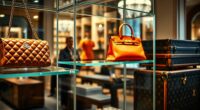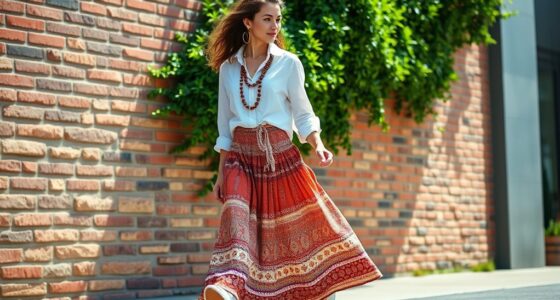Boho style started in the 1960s as a rejection of mainstream fashion, emphasizing individuality, handcrafted pieces, and a connection to nature. During the 70s and 80s, it evolved by blending cultural influences from around the world and incorporating ethnic textiles and layered accessories. Today, it’s all about sustainability, vintage vibes, and modern twists like minimalist accessories. If you keep exploring, you’ll discover how this vibrant style continues to reinvent itself today.
Key Takeaways
- Boho style originated in the 1960s as a countercultural movement emphasizing individuality, nature, and handmade craftsmanship.
- During the 1970s and 1980s, it evolved by blending ethnic textiles, layered accessories, and influences from global cultures.
- The style incorporated punk and new wave elements, creating a more eclectic, sophisticated, and worldly aesthetic.
- Modern boho trends focus on sustainable fabrics, eco-consciousness, and minimalist accessories, blending vintage charm with contemporary values.
- Contemporary fashion combines natural fabrics, layered textures, and oversized garments, reflecting the style’s origins and modern sustainability.
The Origins of Boho: Counterculture and Artistic Inspiration
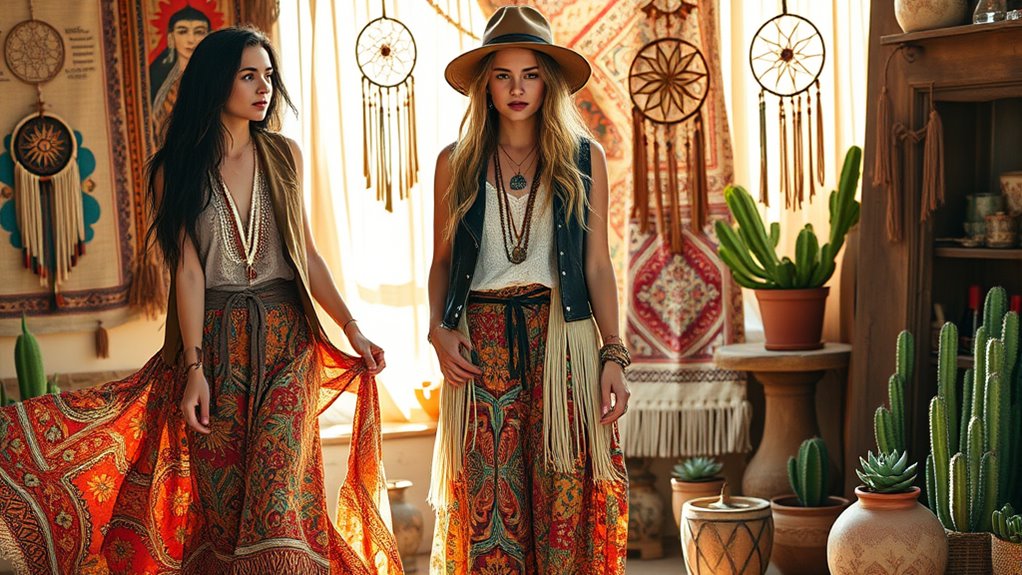
The origins of boho style trace back to the countercultural movements of the 1960s and 70s, when artists and free spirits rejected mainstream fashion and embraced individuality. You’re likely familiar with hippie ideals, which emphasized peace, love, and a connection to nature. These values fueled a desire for authentic self-expression, encouraging people to break away from societal norms. Artistic expression played a crucial role, inspiring fashion that combined handmade items, flowing fabrics, and eclectic accessories. As you explore boho roots, you’ll notice how these elements reflected a rejection of commercialism and a celebration of personal creativity. This movement became a visual language of rebellion, emphasizing freedom, openness, and a desire to live authentically. Additionally, the influence of cultural heritage is evident in the incorporation of traditional craftsmanship and symbolic motifs, connecting modern boho styles to deeper cultural origins. Furthermore, the emphasis on handmade items highlights the movement’s roots in valuing personal artistry and unique craftsmanship over mass-produced fashion. The rustic aesthetic also plays a vital role, drawing from rural and natural environments to emphasize authenticity and simplicity. Moreover, the movement’s connection to artistic inspiration continues to influence modern interpretations, blending vintage elements with contemporary design.
Key Elements and Symbols of the 1960s Bohemian Movement
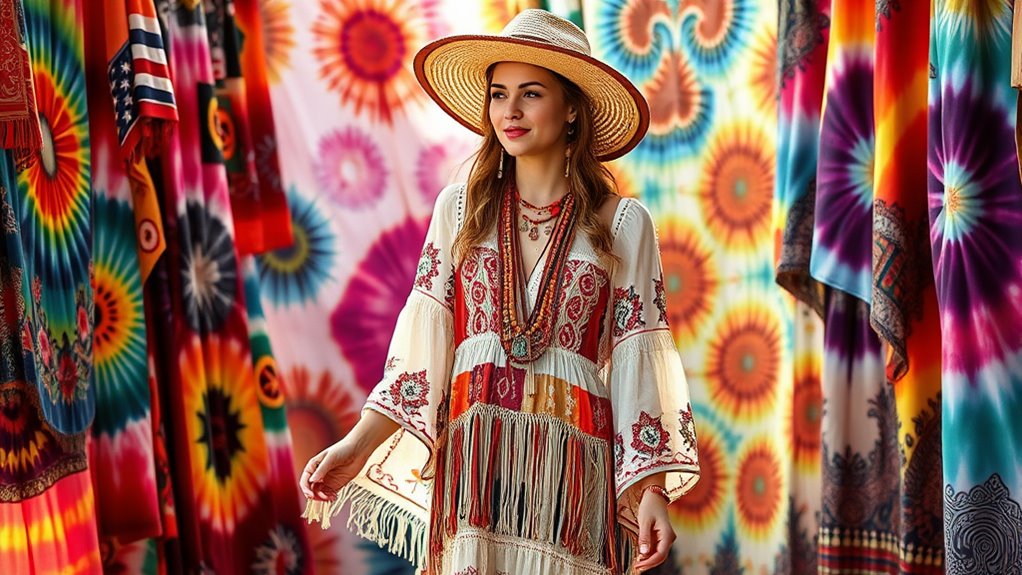
During the 1960s bohemian movement, certain key elements and symbols vividly expressed the ideals of freedom and individuality. Hippie symbolism, like peace signs and love beads, became powerful icons of unity and rebellion. Folk motifs, such as floral patterns and embroidered textiles, reflected a connection to nature and handcrafted artistry. These symbols helped you communicate your rejection of mainstream norms and embrace personal expression. Additionally, the use of sleep solutions for new parents highlights how comfort and safety were also central to the movement’s emphasis on well-being and authenticity. Recognizing the importance of local resources and tools can further aid individuals in understanding and adopting the bohemian lifestyle.
The 1970s and 1980s: Boho’s Evolution and Cultural Influences
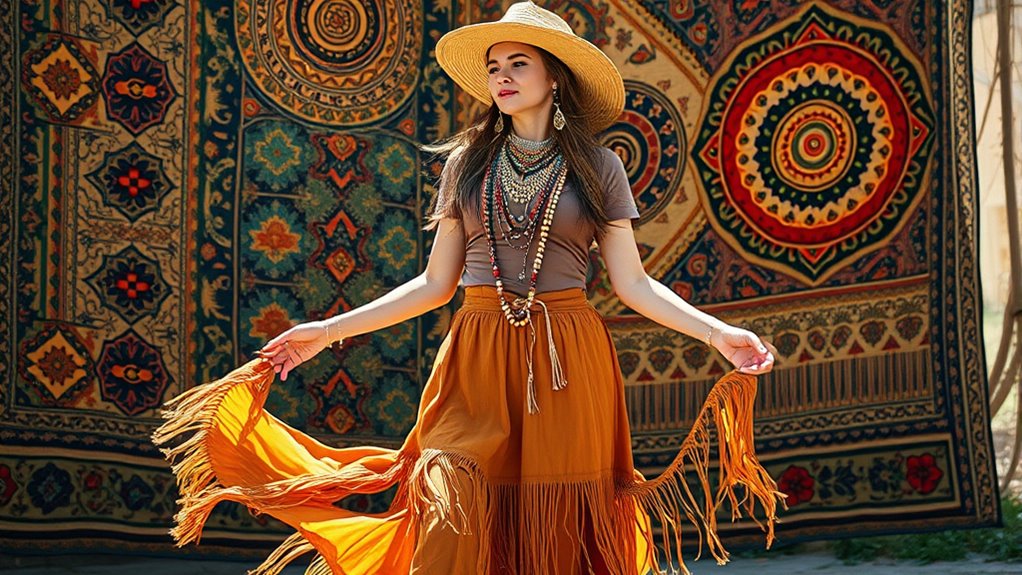
As the 1970s and 1980s unfolded, boho style evolved by blending countercultural ideals with diverse cultural influences, shaping a more eclectic and globally inspired aesthetic. You notice how hippie fashion during this era incorporated elements from around the world, reflecting a cultural fusion that celebrated diversity. This period emphasized individual expression, mixing ethnic textiles, embroidery, and layered accessories. Key influences include:
- Ethnic patterns from Africa, Asia, and Latin America
- The rise of punk and new wave styles blending with boho elements
- An increased focus on handcrafted and artisanal details
- The integration of fashion trends from different eras, further enriching the boho style
This fusion created a more sophisticated, worldly boho look, moving beyond the original 1960s hippie fashion and embracing a broader cultural tapestry.
Modern Interpretations and the Resurgence of Boho Style
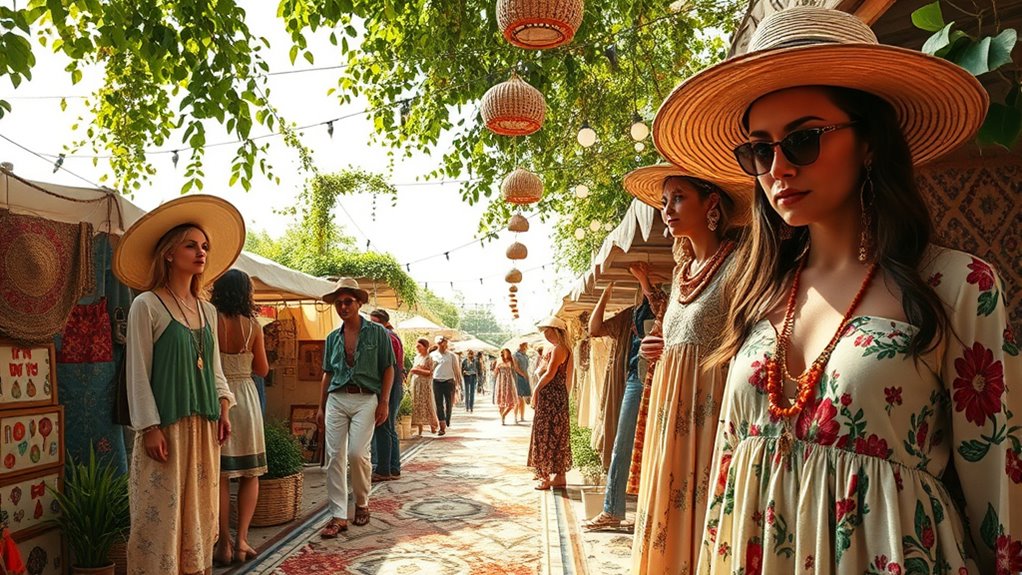
Modern interpretations of boho style draw on its rich history of eclecticism and cultural fusion, but they also respond to current fashion trends and social values. Today, you’ll notice an emphasis on sustainable fabrics, reflecting a growing commitment to eco-consciousness. Designers incorporate organic cotton, hemp, and recycled textiles to create authentic, environmentally friendly pieces. Sustainable fabrics play a key role in making boho fashion more eco-friendly and aligned with modern values. Minimalist accessories have also gained popularity, balancing boho’s free-spirited vibe with clean, simple lines that suit modern tastes. This fusion allows you to embrace boho’s relaxed, layered aesthetic while staying aligned with contemporary sustainability and simplicity. Whether you’re mixing vintage finds with new sustainable pieces or pairing flowing dresses with understated jewelry, these modern adaptations honor the style’s roots while making it relevant for today’s conscious consumers.
Incorporating Boho Aesthetics Into Contemporary Fashion
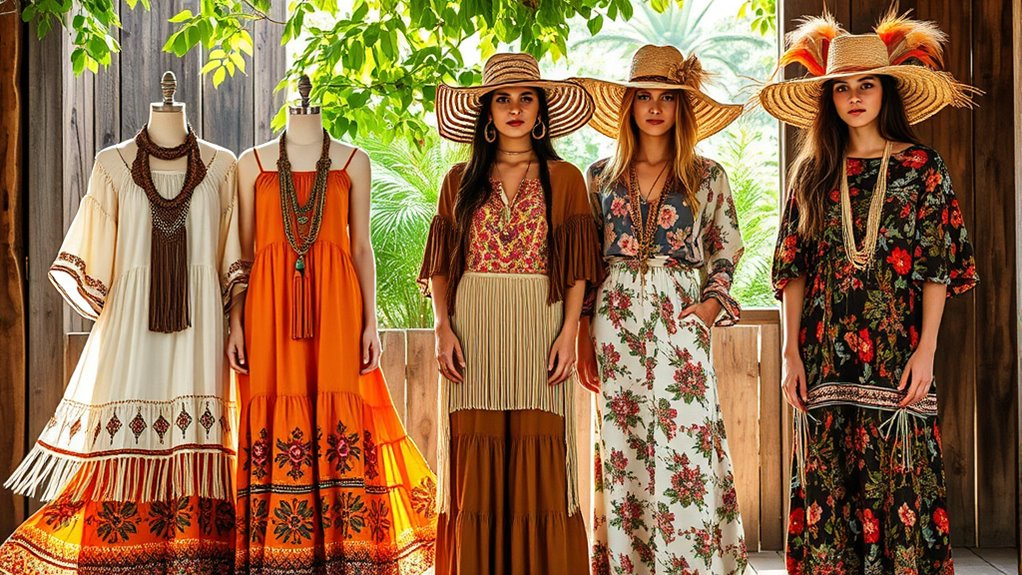
Incorporating boho aesthetics into contemporary fashion involves blending its signature relaxed, layered look with current trends to create versatile, stylish outfits. Focus on using natural fabrics like linen, cotton, and hemp to maintain an earthy feel. Layered accessories, such as stacked bracelets, long necklaces, or floppy hats, add depth and personality. To elevate your style, consider these elements:
- Mix textures and patterns for a boho-inspired, eclectic vibe
- Incorporate oversized, flowy garments for comfort and movement
- Use natural fabrics to enhance authenticity and sustainability
Frequently Asked Questions
How Did Global Events Influence Boho Style Development Over the Decades?
Global events like cultural exchanges and economic shifts have shaped boho style over the decades. You notice how increased cultural interactions introduce diverse patterns and materials, enriching the style. Economic changes, such as downturns, encourage sustainable, thrifted fashion choices, making boho more accessible. These influences help you see boho as a reflection of global interconnectedness and resilience, evolving with societal shifts to stay fresh and meaningful.
What Role Did Specific Artists or Musicians Shape Boho Fashion Trends?
You see, hippie icons and musical influences played a huge role in shaping boho fashion trends. Artists like Janis Joplin, Jimi Hendrix, and the Beatles inspired you to adopt their relaxed, eclectic styles. Their free-spirited looks encouraged you to incorporate flowy fabrics, fringe, and ethnic patterns into your wardrobe. These musicians became symbols of the boho lifestyle, making their influence essential to the movement’s evolving fashion sense.
Are There Regional Variations in Boho Style Worldwide?
Like a tapestry woven from diverse threads, boho style varies worldwide. You’ll notice regional differences shaped by cultural influences and textile traditions, giving each area its unique flair. For example, Indian boho incorporates intricate embroidery, while Moroccan styles feature vibrant patterns. These regional variations reflect local history and craftsmanship, making boho a truly global, eclectic fashion that evolves with local identities and shared bohemian spirit.
How Has Sustainability Impacted Modern Boho Fashion Choices?
Sustainability has considerably shaped your modern boho fashion choices. You’re likely to favor styles made from recycled fabrics, which reduce waste and environmental impact. Ethical sourcing is also important, guiding you to support brands that prioritize fair labor practices and eco-friendly materials. These conscious decisions help you embrace the boho vibe while contributing positively to the planet, blending free-spirited fashion with responsible consumerism.
What Are Future Trends Predicted for Boho-Inspired Fashion?
Did you know that 65% of consumers expect brands to prioritize sustainability? Future boho-inspired fashion will likely focus on innovative sustainable fabrics and unique boho accessories that blend eco-consciousness with style. Expect more handcrafted details, vintage-inspired pieces, and eco-friendly materials, making your wardrobe both trendy and environmentally responsible. You’ll see a shift toward personalized, artisanal items that reflect individuality while supporting sustainable practices.
Conclusion
So, now that you’ve mastered the boho timeline, go ahead—ditch those boring clothes and embrace the carefree, artsy vibe. After all, who wouldn’t want to channel 1960s rebels, 70s flower children, and today’s trendsetters all in one effortlessly eclectic look? Just remember, if you start looking like a walking thrift store, it’s all part of the authentic boho charm. Happy styling—your inner free spirit is waiting to be unbound!

